
|
||||||||||||||||||||||
 |
||||||||||||||||||||||
 |
||||||||||||||||||||||
 |
||||||||||||||||||||||
 |
||||||||||||||||||||||
 |
| The current issue is always free to everyone |
|
|
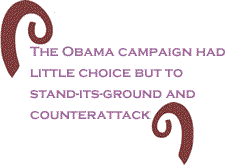
|
This is my fifth Black Commentator article analyzing the course of the historic campaign of Senator Barack Obama for the Democratic Party presidential nomination. In this article I will discuss important contextual events which occurred during the interim between the important March 4th Ohio/Texas primaries and the April 22nd Pennsylvania primary, on the one hand, and the electoral dynamics of the Pennsylvania primary, on the other hand. The important contextual events warranting discussion here are the following:
Contextual Events Underlying The Penna. Primary
In light of what the New Republic magazine's lead editorial article keenly diagnosed as the Clinton campaign's “kneecap-Obama” strategy, the Obama campaign had little choice but to stand-its-ground and counterattack. This was especially so given the fact that Hillary Clinton and her campaign advisers chose to label Obama as sympathetic to an African-American United Church in Christ clergyman, Rev. Jeremiah Wright, who occasionally preached sermons in which he overplayed the activist social-gospel religious critique of America's White supremacist practices against its Black citizens, failing to lace it with a greater humanist-Christian ethos as the great Rev. Martin Luther King instinctively knew how to do. |
|
This, Obama did on March 18th, through delivering a brilliant and historic two-hour address at Philadelphia's Independence Hall on America's thorny racial legacy, America's racist interface with its African-American citizens. As I remarked on Obama historic address in the special section of commentary on it in Black Commentator (March 20, 2008):
|
As an historic quintessential American text warranting a place next to Rev. Martin Luther King's 1963 March-On-Washington address, Senator Barack Obama's Independence Hall address conveyed fulsome intellectual and moral authenticity. It thereby resonated with broad multiracial/multicultural constituencies, as indicated by polls taken during the two weeks after the address, showing some 70% of voters saying that Obama's electability was not diminished because of his attendance at Rev. Jeremiah Wright's liberation-theology activist United Church in Christ. However, these Obama-supporting poll results did not end what the New Republic magazine candidly and correctly dubbed the “kneecap-Obama” Clinton campaign strategy against Barack Obama. Rather the Obama-supporting poll results only slowed down the quite nasty “kneecap-Obama” Clinton strategy. After all, Clinton and her advisers understood that there would be other opportunities ahead that their cynical “kneecap-Obama” strategy could easily exploit, thereby reinforcing the disinclination of working-class White voters in Pennsylvania (and later in Indiana, West Virginia, North Carolina,Kentucky, Oregon, Montana, South Dakota ) to vote for an African-American candidate for the Democratic presidential nomination. Obama's “Bittergate” Comment Cost Him Some Momentum Senator Obama committed a tactical error during a private fund raiser event in California on April 6th when he remarked that many working-class White voters he encountered campaigning in the towns of Pennsylvania felt “bitter” about their economic plight and that this unhappiness got reflected in their social and political outlook . “They cling to guns or religion or antipathy to people who aren't like them...”, as Obama put it. Obama never imagined, however, that his words would immediately become cannon fodder for Hilliary Clinton's against him.
Indeed, Obama's “Bittergate” formulation unwittingly provided broad assistance to the Clinton campaign's cynical “kneecap-Obama” message, which was propagated nationwide by cable television stations (CNN & Fox News especially) and by a legion of rightwing Talk Radio hosts, all of whom pounced fervently on Obama's remarks, cleverly labeling them and Obama as “elitist”. As Hillary Clinton formulated this new assault on Senator Obama, she said his “Bittergate” remarks were “not reflective of the values and beliefs of Americans.... People embrace faith not because they are materially poor, but because they are spiritually rich.” Of
course, Obama had to back down from his somewhat leftist characterization
of the interplay between working-class White citizens' social
discontent and their religious and political choices, because
it amounts to a one-dimensional observation of such socio-political
patterns in our society. Thus Obama admitted the error of his
observation, saying he had used “ill-chosen words”. Accordingly, Obama's gaffe can be viewed as a tactical error in that he failed to understand that when he's offering political discourse at either private fund raisers or public events, the situations are not academic-debate milieu but real power-game milieu. Which is to say, they are milieu in which a politician's words might arry heavy political consequences. This understanding was clearly not at the forefront of Barack Obama's consciousness at the California fund raiser on Sunday, April 6th. It should have been. I say this because, owing to his “Bittergate” gaffe, the Obama campaign was incapable of mobilizing for its own political advantage a series of political faux pas on the part of the Clinton campaign. One such political faux pas occurred in mid-March when Clinton, seeking to bolster her foreign-policy credentials, patently lied during several public speeches about landing in Bosnia 1996 during an official tour when gun-fire between opposing groups riddled the airfield she landed on. “I certainly do remember that trip to Bosnia”, Clinton remarked while campaigning in Blue Bell, Pennsylvania, in late March 2008.
Another Clinton campaign political faux pas took place a week after Obama's April 6th fund-raiser gaffe. The leading front-page article in the Boston Globe (April 7, 2008) on the campaigns in Pennsylvania was titled “Top Strategist For Clinton Quits Post Amid Uproar”. The article reported the removal of Mark Penn from his powerful post as chief strategist for Clinton, owing to his participation as lobbyist for the government of Columbia's bid to have a trade pact with the United States enacted—a pact that major trade unions strongly oppose. Yet Clinton campaigns in economic-depressed areas of Pennsylvania (Pittsburgh, Scranton, Hazelton, etc.) pronouncing opposition to the Columbia trade pact with the United States. Of course,this rather bald duplicitous politics surrounding Clinton's official posture toward the Columbia trade pact (publicly opposing the trade pact while here chief campaign strategist was paid millions of dollars for lobbying for it) was a sitting-target for critical fire from the Obama campaign, but Obama's “Bittergate” misstep canceled-out this opportunity. A Note On The Toxic Issue Of Race In Life & Politics I suspect, however, that even had the “Bittergate” misstep never occurred, the Obama campaign would have nonetheless experienced much difficulty in persuading anything like a sizable segment of working-class White voters in economic-depressed urban and rural areas of Pennsylvania warming-up to his candidacy. After all, the racial mindsets among working-class Whites in Pennsylvania are, shall we say, not yet inclined toward the kind of multiculturalization involved in voting for a Black presidential candidate. The columnist Bob Herbert candidly addressed this issue in the New York Times (April 15, 2008):
Moreover, Bob Herbert's forthright characterization goes further and provides us a keen understanding of the dynamics that enable the Clinton campaign to maneuver Senator Obama's gaffe-- his “Bittergate” ill-chosen words—into an easy political missile for Hilliary Clinton to toss in Obama's campaign path. As Herbert put it:
Thus
there is little doubt that Obama's “Bittergate” remark cost his
campaign some momentum. It assisted the Clinton campaign's skillful
and cynical “kneecap-Obama” maneuvers, especially owing to the
cynical willingness of Hillary Clinton and her advisers to, as
Bob Herbert put it, manipulate the “toxic issue” of persistent
racist motivations among some of Pennsylvania's White voters.
 It'll
take perhaps another whole generation before such White voters
shift toward a new kind of multiculturalization of their American
identity. It'll
take perhaps another whole generation before such White voters
shift toward a new kind of multiculturalization of their American
identity.This, I believe, will be looked back upon 30 years down-the-road as a major legacy of Barack Obama's campaign for the 2008 Democratic Party presidential nomination. When it comes to the “toxic issue” of race in American life today, the Obama campaign has taken the high road, which he did both intellectually and morally in his historic Independence Hall address on March 8th. The Obama campaign has accordingly left the low-road pattern of relating to the “toxic issue” of race in American life to the cynical and vulgar manipulations of Hillary Clinton and the Clinton campaign advisers. And as the lead editorial on the Pennsylvania campaign that appeared in the New York Times (April 23, 2008) observed, “It is past time for Senator Hillary Rodham Clinton to acknowledge that the negativity [in the Pennsylvania primary contest], for which she is mostly responsible, does nothing but harm to her, her opponent, her party and the 2008 election.” Characteristics Of Voter Blocs Shaped The Penna. CampaignAs the Pennsylvania campaign proceeded through the three weeks of April until election day on April 22nd , the Clinton campaign not only persisted in employing what can be called “race-card maneuvers”. Which is to say, maneuvers that were attentive to working-class White voters' unenlightened racial mindsets, attentive to working-class Whites disinclination to vote for a Black candidate for the Democratic Party presidential nomination.
Given the cynical preference of Hillary Clinton to exploit the toxic issue of race, the demographic attributes of the voter blocs in Pennsylvania facilitated the execution by the Clinton primary campaign a “kneecap-Obama” strategy. By the start of April, polls taken of the pre-primary voter-bloc preferences in Pennsylvania suggested that the Clinton campaign's “knee-cap Obama” strategy (“throw kitchen-sink-at-Obama”, as Clinton's advisers put it) might very well yield pro-Clinton results on primary election day, April 22nd. As shown in TABLE I, a series of polls taken by mid-April suggested that two key White voter-blocs-- White women and the 50-plus age group-- strongly favored Hillary Clinton. These two White voter-blocs, in turn, constituted large proportions of Democratic voters in Pennsylvania—White women being nearly two-thirds of such voters, for instance.
As of April 23rd –day after the Pennsylvania primary election—only a scattering of Exit Poll data on the voter-blocs were available to me. I have organized that limited data in TABLE II.
In relying on scattered reports of Exit Poll results in major newspapers, I've been able to cull out results like the following. The Wall Street Journal (April 23, 2008) reported that: “Women made up roughly six out of 10 voters [in Pennsylvania], and Sen. Clinton got a clear majority. ...Among whites, Sen. Clinton got the majority of men's votes and an overwhelming majority of women's. ...Catholics were more than a third of the voters, and Sen. Clinton won their support by two-to-one.” In a summary statement on the overall range of White voter-blocs that favored Hillary Clinton, the Wall Street Journal observed as follows:
What About Barack Obama Votes & Especially Black Votes Let me point out first that I was rather bemused—perhaps baffled—by the fact that throughout both the newspaper reporting (I followed six newspapers) and television news reporting on the Pennsylvania election, there was an almost manic interest in the fact that Hillary Clinton dominated working-class White votes in their different voter-bloc categories (e.g., Catholic voters, medium-to-low income voters, non-college graduates, White men, older-age Whites, etc.). And this interest was translated into rather celebratory reports—in the Boston Globe, the New York Post, USA Today, the Wall Street Journal, the Philadelphia Inquirer, etc.--which emphasized Hillary Clinton's electoral success among working-class White voters.
I suggest that had the journalists at major national-level or regional-level newspapers (New York Times, Washington Post, Philadelphia Inquirer, Boston Globe) kept abreast to some degree of African-American societal and civic institutions in Pennsylvania, they would not have produced the rather obsessive attention to Clinton's gaining a majority of working-class White votes as the key or defining dynamic in the 2008 Pennsylvania primary election. Quite the contrary. Had they paid just some attention to African-Americans' societal and civic agencies—especially in Philadelphia and Pittsburgh—they would have recognized something then clearly know nothing about. Namely, they would have recognized the serious and masterful role performed by Black clergy and churches, Black schoolteachers associations, Black academics, Black professional groups (lawyers, doctors, dentists, nurses), Black business groups (shopkeepers, barbers, hairdressers, artisans, funeral directors, banks, technologists of all sorts, etc.) in producing record-breaking Black electoral participation in the Pennsylvania primary election.
As a result, it was mainly the task of the Black Philadelphia's professional and civic agencies and leaders, reinforced by the electoral resources of the Obama campaign, to produce record-breaking Black electoral participation in the Pennsylvania primary election. The story of this important experience during the course of the 2008 Pennsylvania primary is recorded in the pages of perhaps the doyen big-city newspaper produced by African-Americans—namely, The Philadelphia Tribune.
A somewhat similar take on the Black vote in the Pennsylvania primary occurred in the report offered in the Wall Street Journal (April 23, 2008). As that newspaper informed us:
Concluding Note: Wither The Democratic Nomination Process What presently appears as a crisis in the political campaigns contesting for the Democratic nomination—and it is only a minor and temporary crisis I believe—can be placed squarely at the door of Hillary Clinton and her campaign apparatus. There are several types of evidence to sustain this claim. First, polls taken after the Pennsylvania primary show that a solid majority of Democratic voters place blame for “the crisis” at the door of the Clinton campaign. As the Wall Street Journal (April 23, 2008) reported this situation:
 Among leading liberal national-level newspapers, the New York Times decided to take the lead in firmly chastising Hillary Clinton and her campaign apparatus not only for what I have dubbed a “kneecap-Obama” strategy. But for executing this cynical campaign strategy at the lowest rung on ladder of values and moral norms. As the New York Times (April 23, 2008) formulated its chastisement of the Clinton campaign:
A
parallel version of the above editorial observation by the New
York Times was offered by the columnist Maureen Dowd.
In the New York Times (April 23, 2008), Dowd observed
that Be that as it may, a post-Pennsylvania primary report in the USA Today (April 23, 2008) made two things clear about wither the crisis of the Democratic nomination contest. First and above all, it observed that “The Illinois senator [is] leading in national polls, states won, and pledged delegates....” It could have also noted that Obama is leading in total votes gained: 13,400,000 Obama to 12,600,000 Clinton. However, the same issue of the USA Today carried the only report I've seen on Senator Barack Obama's address to an audience over 7,000 in Evansville, Indiana, the evening of the Pennsylvania election. The USA Today reported as follows on what Obama said:
I would say that Senator Barack Obama's prognosis is sound. May it turn out to be so in the November presidential election. BlackCommentator.com
Editorial Board member Martin Kilson, PhD hails from an African Methodist background and
clergy: From a great-great grandfather who founded an African
Methodist Episcopal church in Maryland in the 1840s; from a
great-grandfather AME clergyman; from a Civil War veteran great-grandfather
who founded an African Union Methodist Protestant church in
Pennsylvania in 1885; and from an African Methodist clergyman
father who pastored in an Eastern Pennsylvania mill town - Ambler,
PA. He attended |
Your comments are always welcome. e-Mail
re-print notice
If you send us an e-Mail message we may publish all or part of it, unless you tell us it is not for publication. You may also request that we withhold your name. Thank you very much for your readership. |
|
| April 24, 2008 Issue 274 |
|
| Executive Editor: Bill Fletcher, Jr. |
| Publisher: Peter Gamble |
| Est. April 5, 2002 |
| Printer Friendly Version in resizeable plain text format format |
 |
 |
 |
| |
| |




















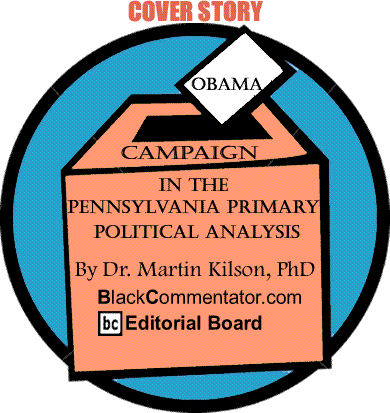
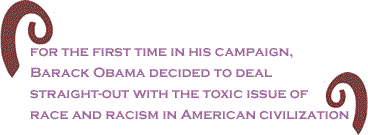 The
importance of the above-mentioned contextual events underlying
the Pennsylvania primary is that they can shape what might be
called “citizens' electoral temper” in a closely contested election,
which what the Pennsylvania primary was.
The
importance of the above-mentioned contextual events underlying
the Pennsylvania primary is that they can shape what might be
called “citizens' electoral temper” in a closely contested election,
which what the Pennsylvania primary was. 
 The
purpose of this facet of Clinton campaign's cynical “knee-cap
Obama” strategy was, no doubt, to reinforce Clinton's support
among working-class White voters in Pennsylvania (one-third
of Democratic voters in the state) who polls showed favored
Clinton by 2-1 over Obama. Here the Clinton campaign was employing
the “race card”— a crypto-racist maneuver if you will—and Senator
Obama decided to challenge the Clinton “kneecap-Obama” maneuvers
head-on, as it were. Rather than skirting-around-racial-issues
as he had done up to this point, for the first time
in his campaign, Barack Obama decided to deal straight-out with
the toxic issue of race and racism in American civilization.
The
purpose of this facet of Clinton campaign's cynical “knee-cap
Obama” strategy was, no doubt, to reinforce Clinton's support
among working-class White voters in Pennsylvania (one-third
of Democratic voters in the state) who polls showed favored
Clinton by 2-1 over Obama. Here the Clinton campaign was employing
the “race card”— a crypto-racist maneuver if you will—and Senator
Obama decided to challenge the Clinton “kneecap-Obama” maneuvers
head-on, as it were. Rather than skirting-around-racial-issues
as he had done up to this point, for the first time
in his campaign, Barack Obama decided to deal straight-out with
the toxic issue of race and racism in American civilization.
 Legalized
discrimination—where blacks were prevented, often
through violence, from owning property—meant that
black families could not amass any meaningful wealth to
bequeath to future generations. That history helps explain
the wealth and income gap between black and white in so
many of today's urban and rural communities...This is the
reality in which Reverend [Jeremiah] Wright and other African-Americans
of his generation grew up. They came of age in the late
fifties and early sixties, a time when segregation was still
the law of the land and opportunity was systematically constricted.
Legalized
discrimination—where blacks were prevented, often
through violence, from owning property—meant that
black families could not amass any meaningful wealth to
bequeath to future generations. That history helps explain
the wealth and income gap between black and white in so
many of today's urban and rural communities...This is the
reality in which Reverend [Jeremiah] Wright and other African-Americans
of his generation grew up. They came of age in the late
fifties and early sixties, a time when segregation was still
the law of the land and opportunity was systematically constricted.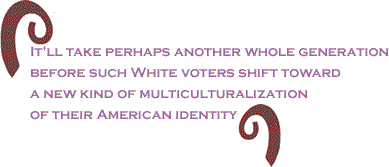
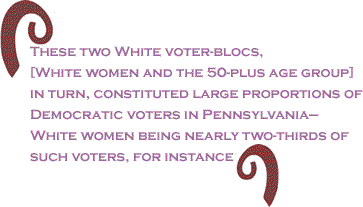 The
Clinton campaign calibrated many aspects of its campaign message—the
style and modality of its political appeal—with a keen eye to
the demographic layout and attributes of voter blocs in Pennsylvania.
Its goal was to win the Pennsylvania primary election at a high
double-digit victory margin and. As it happened, Clinton won
the Pennsylvania primary election by a low-range double-digit
victory margin—55% to 45% for Obama, a 10 percentage point victory
margin. This, however, is apparently a preliminary figure, because
an NBC Television News report on April 23rd claimed that when
total tally of 100% of Pennsylvania precincts is available,
the correct Clinton victory-margin will be under 10%-- just
9.4%.
The
Clinton campaign calibrated many aspects of its campaign message—the
style and modality of its political appeal—with a keen eye to
the demographic layout and attributes of voter blocs in Pennsylvania.
Its goal was to win the Pennsylvania primary election at a high
double-digit victory margin and. As it happened, Clinton won
the Pennsylvania primary election by a low-range double-digit
victory margin—55% to 45% for Obama, a 10 percentage point victory
margin. This, however, is apparently a preliminary figure, because
an NBC Television News report on April 23rd claimed that when
total tally of 100% of Pennsylvania precincts is available,
the correct Clinton victory-margin will be under 10%-- just
9.4%.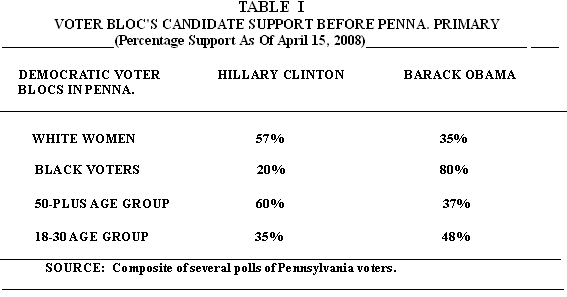
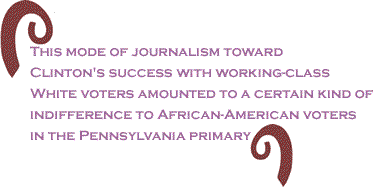
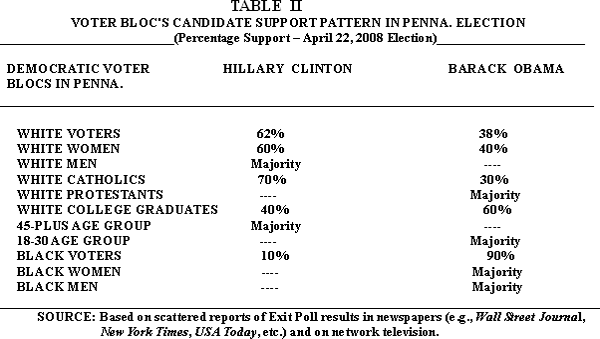

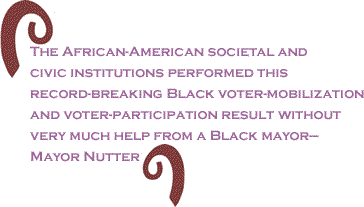 Now
I think this mode of journalism toward Clinton's success with
working-class White voters amounted to a certain kind of indifference
to African-American voters in the Pennsylvania primary. While
not quite 35% of the Democratic Party voters in Pennsylvania
are working-class White voters, the Black voter-bloc was 15%
of Democratic voters, which broke down into 8% Black women voters
and 7% Black men voters. What is more, any one with genuine
respect for African-American citizens' participation in the
crucial place of the Pennsylvania primary in the 2008 campaign
year, would have kept abreast of African-American societal and
civic agencies like Black churches, Black fraternal groups like
Prince Hall Masons and Greek-Letter societies, Black mutual-aid
associations, Black radio stations, and especially Black newspapers
like the great journalism institution called The
Philadelphia Tribune.
Now
I think this mode of journalism toward Clinton's success with
working-class White voters amounted to a certain kind of indifference
to African-American voters in the Pennsylvania primary. While
not quite 35% of the Democratic Party voters in Pennsylvania
are working-class White voters, the Black voter-bloc was 15%
of Democratic voters, which broke down into 8% Black women voters
and 7% Black men voters. What is more, any one with genuine
respect for African-American citizens' participation in the
crucial place of the Pennsylvania primary in the 2008 campaign
year, would have kept abreast of African-American societal and
civic agencies like Black churches, Black fraternal groups like
Prince Hall Masons and Greek-Letter societies, Black mutual-aid
associations, Black radio stations, and especially Black newspapers
like the great journalism institution called The
Philadelphia Tribune.  Furthermore,
the African-American societal and civic institutions performed
this record-breaking Black voter-mobilization and voter-participation
result without very much help from a Black mayor—Mayor
Nutter. Nor help from Pennsylvania Governor Rendell, although
he owes his successful political career (first as mayor of Philadelphia
then as state governor) to the voter-mobilization role of African-American
societal and civic institutions. The Philadelphia mayor and
the Pennsylvania's governor backed Hillary Clinton and her campaign—deferring
blindly to the old-fashioned city machine loyalty values and
rules that define the Clinton Machine.
Furthermore,
the African-American societal and civic institutions performed
this record-breaking Black voter-mobilization and voter-participation
result without very much help from a Black mayor—Mayor
Nutter. Nor help from Pennsylvania Governor Rendell, although
he owes his successful political career (first as mayor of Philadelphia
then as state governor) to the voter-mobilization role of African-American
societal and civic institutions. The Philadelphia mayor and
the Pennsylvania's governor backed Hillary Clinton and her campaign—deferring
blindly to the old-fashioned city machine loyalty values and
rules that define the Clinton Machine.






